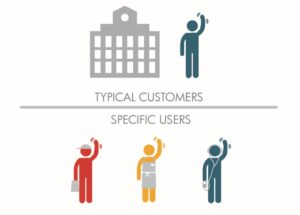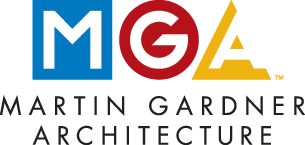The endeavor of a new building project can be a daunting task, especially if an owner has no experience in design or construction. Once an owner has determined that a new building, addition, or renovation is needed to do business, then begins the phase of internal analyzation and decision making. These potentially tedious tasks can include determining budgets, establishing a building site, hiring consultants, analyzing existing conditions and functions, or even something as simple as selecting a paint color. At MGA we have the tools and strategies integrated into our process to make each of these steps move ahead efficiently to establish the ideal design for your new space.
One of the initial strategies we use to determine each client’s unique needs is by identifying User Personas. It is crucial to understand each project’s different challenges, advantages, desired outcomes, and identity. This information equips designers to create an improved space to better your everyday function. By asking questions and becoming more familiar with your crew and those you serve, MGA can create a design that will fit the exact goals, needs, mission, and future challenges of your organization.
WHAT IS A USER PERSONA TOOL?
The user persona tool gathers everyone who may use your space or building at the end of the project and in the future. These might include your key decisions makers, leaders, your staff and your faithful patrons. These are the individuals that will know the most about the needs and strengths of your organization and are able to determine issues that should be addressed in your new design. This tool consists of many determining questions that will help our design team move forward. Some sample User Persona questions include:
- What are the various positions in your organization?
- Who will be typical patrons of the building?
- What should their experience look like?
- How do they arrive at the site?
- What should they see and not see as they approach the building?
- How are they greeted at the entry?
- What is the sequence of events for this person while they are here?
- What will make their job more enjoyable? More efficient?
- What are obstacles that slow them down?

HOW DOES IT WORK?
Say we are approached by the owners of a local coffee shop called The Coffee Place, and they need a new space. Through utilizing the User Persona Tool with our new client, we can learn the following information about their business:
- The company uses quality, sustainable, local ingredients and environmentally friendly packaging to provide a high-end experience.
- The company is deeply connected to their community, and desire to help promote local economic growth in any way they can. They have outgrown their current retail space, and desire to move even closer to downtown to be near their vendors and the heart of the city.
Let’s discuss two sample User Personas, typical customers and specific users, for this hypothetical business to illustrate how further information can inspire the design process. The typical customers for The Coffee Place are college students from the nearby campus area. All student customers arrive on foot, by bus, or may get dropped off by car. Given the high pedestrian traffic, designing a more efficient loading zone with better visibility, signage, and safety measures would be ideal. The specific user narratives can be created from individual interviews, social media, and focus groups to help inform the nuanced experience of patrons and building users. This better illustrates specific strengths and deficiencies of an existing space. Here are examples of specific individual user narratives in relation to The Coffee Place:
- Jessica is a college student that has a typical daytime schedule and an evening part-time job. She has a heavy course load and typically not much time to socialize. She will come in and take a booth, open her laptop, put in the headphones, do homework, and catch up on social media before her first class at 10 AM. She only stays for approximately 45 minutes after a cup of joe and a slice of egg bake. It would be better if she used a smaller 2-person bistro table or lounge chair to save room for other patrons, but these currently aren’t available.
- Chelsea is a full-time barista and manager at The Coffee Place. It drives her crazy to see her staff entering through the front entrance. It is distracting to customers and doesn’t make the organization feel as professional as she would like. A separate entrance for deliveries and staff is a must in the new space. During rush hour moments, everything needs to be about reducing steps and having the back-of-counter area arranged in a way that common ingredients are convenient and easy to find. Chelsea also has activities that she needs privacy and quiet for, including calling in orders, paying invoices, meeting with staff members, storing employee records, and a place for Owners Jenn and John to talk about administrative business issues.
- Charlie is a dad on the go, works in the college maintenance department, and volunteers for a local non-profit. He comes in the morning and does not have much time after dropping his kids off at school. He typically waits at the counter for his morning coffee and lunch sandwich and takes off out the door as soon as it’s ready. He and other customers would appreciate a pickup window. Charlie also returns in the evenings for community fundraiser events hosted in the main seating area. It would be better to have more flexible furniture in the space to make room for events and to maintain the strong relationships with non-profits in the community.

WHY IS THIS INFORMATION IMPORTANT?
We have now compiled a small library of information to build our understanding of who The Coffee Place is and what to consider as we begin the process of creating a new space for them. We now understand that:
- There is a need for more private quiet areas in the space to accommodate for the large student population that occupies The Coffee Place. We can create a positive study environment through advantageous space planning and using strategic materials such as partitions or noise dampening ceiling clouds.
- The Coffee Place could have more seating options that cater to individuals, like armchairs or barstools, to create opportunities for customers not in large groups to stay in the space comfortably.
- The sequence and efficiency of staff operation needs to be organized and improved. We can use space planning strategies to provide convenient staff and delivery access and create behind the counter space that improves functionality for employees to work more efficiently.
- There needs to be a private office area to accommodate owner and employee meetings and to house items pertinent in keeping the business successful and thriving. Allocating this area away from busy traffic areas of the café will provide the privacy and security needed.
- Customers would greatly appreciate a pickup window or other pickup options that are close to the main entrance so they can quickly enjoy The Coffee Place on the go as their busy schedules allow.
- The Coffee Place is a staple in the community and is used for other events and purposes besides dining, meeting, and studying. By utilizing flexible and movable seating arrangements and storage, the space can continue to be a great way to connect with the city’s non-profits and other organizations.
This user persona tool is a simple and informative process to help focus the efforts of both the client and the designers. At MGA we want to create spaces that promote who you are as an organization and to improve where you live, work, and play. We have developed many tools like this to help inform our design process and create spaces that will help your business or organization grow. Stay tuned as we continue to illustrate our design process to make your prospective project a smooth transition and an ultimate reality and success!
